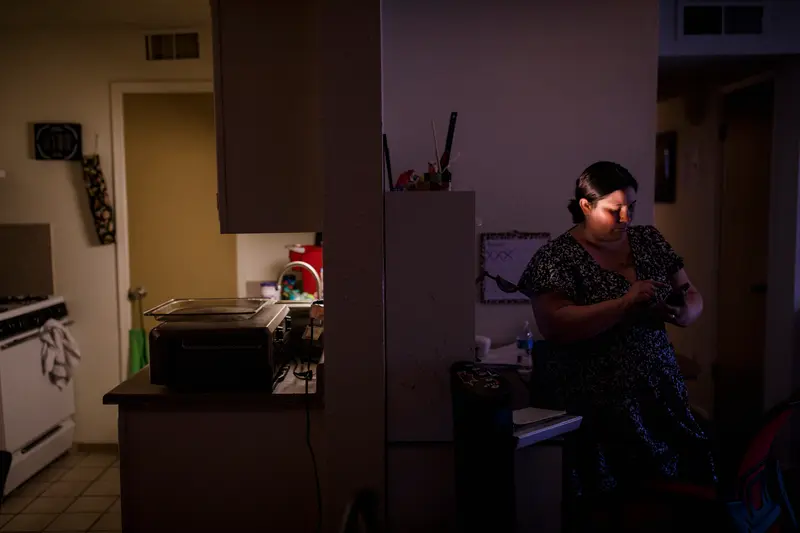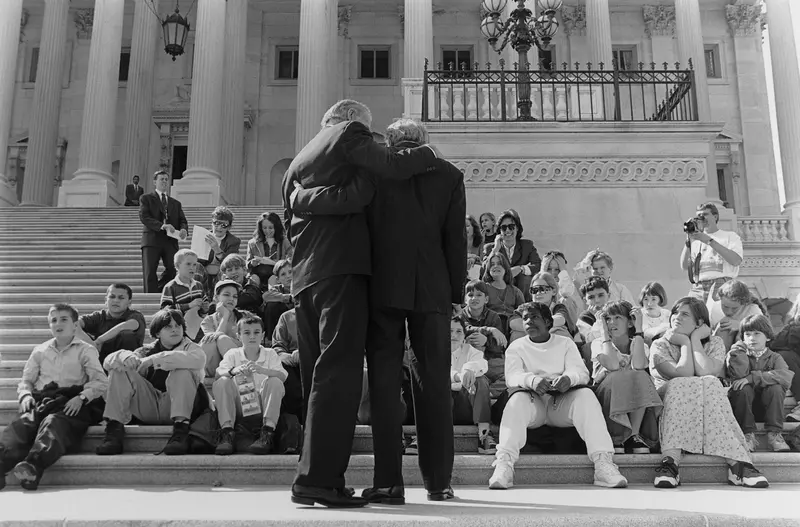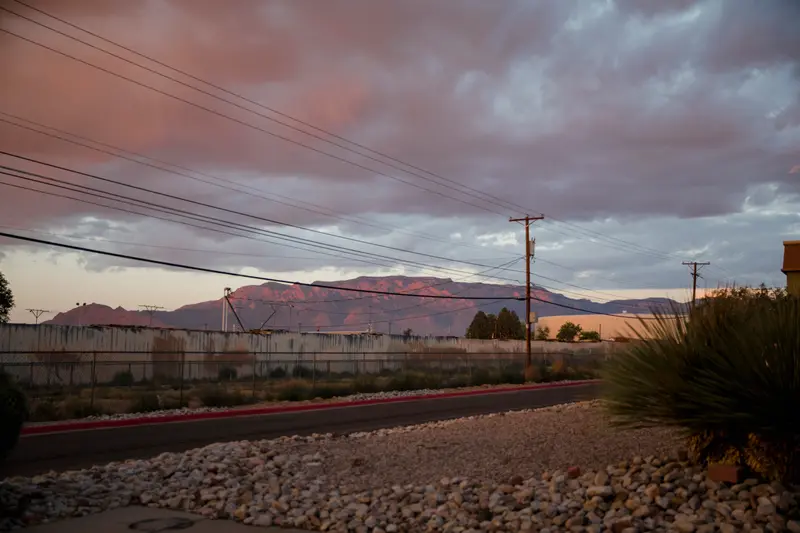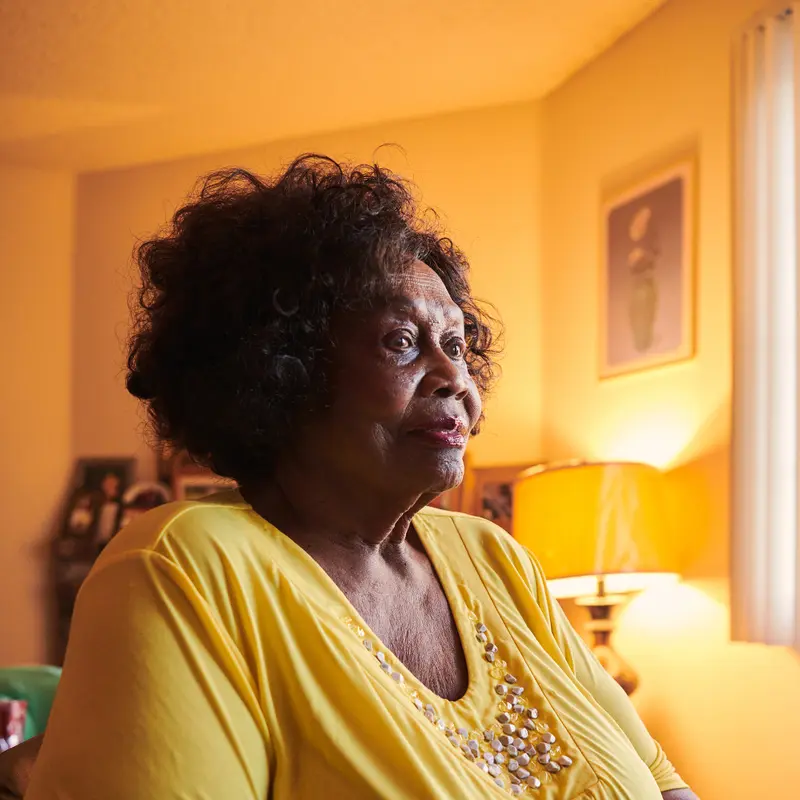This article was co-published with the Las Vegas Sun.
As the 1960s came to their tumultuous end, California Gov. Ronald Reagan convened a summit on the topic of welfare. He was hoping to try out one of his new ideas: that poor single mothers were, in the wake of the civil rights movement, increasingly living idly and defrauding government assistance programs.
George Miller, then the welfare director in neighboring Nevada, volunteered to do a dry run for Reagan, proposing to purge his smaller state’s welfare rolls of alleged welfare cheats. It would be the first effort of its kind in the nation, he said.
Miller cut Nevada’s aid program by close to 75%, stripping thousands of moms and kids of desperately needed survival assistance.
Ruby Duncan, a self-described “welfare mother” on Las Vegas’s Westside, was incensed.
Duncan had grown up in Tallulah, Louisiana, in the 1930s, chopping and picking cotton on a plantation. When her uncles joined the Great Migration out of the South and headed to Vegas to work on New Deal projects like the Hoover Dam, she followed, becoming a maid at still-segregated casino hotels and a house cleaner for wealthy entertainers at the height of the city’s Rat Pack glory days.
She worked from sunup to sundown for decades, and only reluctantly received minimal government help after she literally broke her back on the job. (Duncan permanently injured her spine when she slipped while carrying overloaded trays of food to customers at the Sahara hotel.)
In March 1971, in response to Miller’s welfare cuts, Duncan organized a series of marches down the Las Vegas Strip, a protest movement dubbed “Operation Nevada.” Thousands of welfare mothers, children, priests and nuns, union members, students and well-known activists including Jane Fonda and Ralph Abernathy succeeded in blocking the way into Caesars Palace and other casinos, threatening the bottom line of the city’s wealthiest.
“It was very exciting,” Duncan said. “The fancy people were grabbing their furs and closing their cash registers.”
The marches received national news attention. Duncan followed them up with several “eat-ins,” in which she and her fellow organizers instructed dozens of children left hungry by the welfare cutbacks to walk into luxurious casino dining rooms, order steaks, and then walk out without paying, telling the restaurant managers to bill the state welfare department instead.
Within weeks, a federal judge ordered that the moms and kids whom Nevada had slashed from public assistance would have their benefits reinstated.
In the following years, Duncan expanded her political advocacy and won more victories, including getting Nevada to provide food stamps (it was the last state in the nation to do so) and helping to popularize the idea of a universal basic income, a guarantee of a survival level of income for all.
Other Black women nationwide had also started to do this work, connecting the words “welfare” and “rights” for the first time in American history as part of the National Welfare Rights Organization. It seemed like Reagan’s thesis was being defeated, and that the idea had taken hold that poor single mothers do work hard and strive, and are in many ways the backbone of this country.

Today, Duncan, months away from turning 90 and now largely unable to walk due to that workplace injury from so many decades ago, is less optimistic. She’s still living in West Las Vegas, and still occasionally getting to engage with young single mothers. (She adores young people.) And she’s still holding out some hope that President Joe Biden’s child tax credit will become law in the new year and create a better safety net for Nevada’s families, though it faces a tough road to passage in the U.S. Senate.
But Duncan has a long view on the history of cash assistance in the U.S., and she has been souring on its prospects ever since Reagan reached the White House and vaulted Nevada’s revanchist attitude toward the working poor into national politics. (Miller, the Nevada welfare director whom Duncan thought she had fought and defeated, joined Reagan’s presidential transition team.)
Then, President Bill Clinton took Reagan’s notions to their apotheosis in his 1996 welfare reform law, which Clinton said would fulfill his promise to “end welfare as we know it.”
In the 25 years since, welfare as we knew it did end, but not because the reform was lifting people out of poverty as promised. Federal welfare funding, which the law froze at 1996 levels, was soon decimated by inflation and demographic shifts — with rapidly growing Nevada faring worst of all, now less able to help poor children than ever. States were also given great discretion over how to spend the money, and many have since used it less to assist families than to backfill budget holes, in turn allowing them to maintain tax breaks for the wealthy.
In the process, welfare, which the new law renamed Temporary Assistance for Needy Families, or TANF, has gone from serving 4.4 million families in 1996 to just 1 million today, despite the U.S. population increasing by 60 million over the same period. Yet child poverty hasn’t budged: Just as was true when the legislation passed, today nearly one in five American children are living below the poverty line, twice the average rate in other developed countries.
“I know from young women talking to me that they’re facing practically the same thing that went on back when I first started,” said Duncan, who was so despondent and physically ailing by the time the Clinton bill was enacted that, she said, she had to go on bed rest. “Poor women throughout America,” she said, “we tried to make everything better for us, and we ended up with this.”
Welfare Reform’s Legacy in the Desert West
This year, the 25th anniversary of welfare reform, happened to coincide with a substantive debate in Congress over a new sort of welfare: the child tax credit, which has been providing low- and middle-income families nationwide with $250 to $300 per child per month during much of the pandemic, but is set to expire Friday. (Biden and most Democrats in the Senate have said they will try to get it extended permanently with a vote as soon as January.)
ProPublica has taken this moment to examine the present state of cash assistance in the U.S., focusing on the Southwest, where massive population growth and a surging cost of living for low-income parents have collided with the region’s libertarian attitude toward government help for the poor.
What ProPublica discovered is an abundance of overlooked stories of bizarre — and mean-spirited — practices on the part of state governments, which were handed near-complete responsibility for welfare under the 1996 law.
And at the root of them all was that same closefistedness toward poor Americans that Reagan conceived of 50 years ago in Nevada.

In New Mexico and other states, single mothers applying for public assistance are forced to identify the father of their child (and his eye color, and his license plate number) and recall the exact date when they got pregnant. In Utah, families seeking aid are subtly pushed to the Church of Jesus Christ of Latter-day Saints, where they’re pressured to get baptized or perform other religious activities, like reading aloud from the Book of Mormon, in order to get help. And in Arizona, poor moms who could have benefited from welfare are instead investigated, at nationally unparalleled rates, by a child services agency funded by welfare dollars.
These practices exist primarily to save money for the states, and by extension their wealthiest taxpayers. The questions that mothers in New Mexico are forced to answer about their child’s father? Those are asked so that the state can go after the dads for child support — most of which the government then pockets. (In 2020, nationally, more than $1.7 billion in child support meant to go to kids instead was taken by federal and state governments.) Utah, meanwhile, has gotten out of spending more than $75 million on public assistance over the past decade by having a private agreement with the LDS Church saying that the state can “count” much of the church’s charitable work as the state’s own. And Arizona balances its budget by diverting more than $150 million annually in welfare funding intended for low-income families — a majority of the money that the state is provided for direct aid to the poor — to its Department of Child Safety, which then uses the dollars to surveil and sometimes separate many of those same families.
Finally, ProPublica revealed, states have hit upon yet another way to skimp on welfare: simply not spending large amounts of their welfare funding at all. Across the nation, more than $5.2 billion in federal funds that are supposed to be going toward fighting poverty are instead sitting unused in state bank accounts, while the women and children whom Duncan has fought for all her life continue to struggle.
Unlike George Miller’s sudden 75% cut to welfare in Nevada in the 1970s, which prompted such immediate, dramatic collective action from the community, what has happened over the past 25 years has been a relatively slow demise.
In other words, it is precisely welfare reform’s unhurried, creeping approach that, in the end, has made it so successful in dismantling cash assistance.
The Slow Smothering of Welfare in Nevada
These failures of welfare reform, ironically, have reached a kind of end stage in Las Vegas, the capital of capitalism and arguably the birthplace of Reagan’s efforts to relegate welfare to the ash heap of history.
That’s because the 1996 law also locked in the amount of federal welfare funding provided to states at ’90s levels, regardless of inflation, population changes or economic downturns. And Nevada, due both to immigration and an overwhelming influx of tech companies and other transplants from California, has transformed demographically more than any other state, with much of that change occurring in Clark County. (Ever the landing place for newcomers, the state is now home to more adults from California than native Nevadans.)
As a result, the per-person value of Nevada’s fixed “block grant” of welfare funds has declined more than anywhere else in the country.
Between 1997 and 2015, the Silver State’s population skyrocketed, by roughly two-thirds, and its housing prices and cost of living shot up as a consequence. In turn, the number of kids living in poverty here more than doubled, from 67,852 to 143,407. That translated to a percentage decline in the actual value of the state’s welfare dollars, per poor child, that was twice the national average.
Now, Nevada gets the smallest population-adjusted grant of federal money in the nation for addressing child poverty: $63 per child, according to 2019 statistics. By comparison, California receives $409.
Former Nevada Gov. Richard Bryan, who became a U.S. senator and was in Congress during welfare reform, said in an interview with ProPublica, “I liked the idea of a block grant because it gave governors flexibility” over how to spend the welfare fund. But, he said, “it didn’t take into account differences between Nevada and slow- or no-growth states.”
The drop in value of Nevada’s federal welfare dollars has been especially devastating because the state has no income tax, which means that despite all the glitzy wealth here, the state government has little ability to provide its own funding for public assistance. Instead, the Legislature relies largely on sales taxes, much of which come from the tourism industry. As a result, state revenue varies season to season and plummets every time there’s an economic crisis, exactly when welfare is most needed.
The Legislature did increase welfare benefits in 2018 — by $3 a month.
Danielle Frolander, of Minden, Nevada, has felt the decline of TANF in a personal, almost literal way. A dental assistant, she applied for help earlier this year after leaving an abusive relationship and struggling to support her kids on her own, she said. Her rent has ballooned amid an influx of Californians that she said has jammed the town’s two-lane roads with “L.A.-type traffic.”
At first, Frolander said, she was receiving over $200 a month from the program, but the amount quickly started decreasing, just like the value of Nevada’s welfare funding overall. (The reason is that the state has a complex formula for weaning families off cash aid over time.) Now she only gets $50, and soon it will be $0.
“It’s kind of silly, these amounts,” she said. “It goes into my gas tank to get to work, and that’s about all.”
Where Welfare Goes From Here
In the final congressional debate before the 1996 law was passed, then-Sen. Joe Biden said, “We should not fool ourselves: There will be people, many of them children, who will fall through the cracks because of this bill.” But he voted for the legislation anyway, citing a “culture of welfare” that was allegedly the cause of stagnation among America’s poor. (Biden has declined to say whether the vote was a mistake; a spokesperson for his presidential campaign in 2020 told NBC News that he tried to make the bill more progressive but faced a bipartisan coalition in favor of the overhaul.)
For years, the harshness and inefficiencies of TANF were not lost on Biden and other Democrats, according to a review of their past comments on the issue, but they sidelined the problem in part because the window of what seemed possible hadn’t shifted since the Reagan era. Even mentioning welfare, for most of the past 25 years, has been a political third rail.

But the tide began to turn, on the left, starting with social science research suggesting that direct cash aid to households with low incomes is the most effective way of alleviating poverty, as seems intuitive. Studies showed that the simple fact of a family having more money leads to kids eating more nutritious food, going to the doctor more often, experiencing lower household stress (which in turn improves their brain chemistry), scoring higher on academic achievement tests, being more likely to go to college, earning more as adults, avoiding crime and living longer.
Research also revealed that the old narrative that most women receiving welfare don’t want to work is, simply, false. These single moms are typically working multiple low-wage jobs, like Duncan was in the ’60s, that don’t pay them enough to support a family.
Duncan said she would prefer welfare be replaced with universal child care, as well as jobs in communities like hers that aren’t make-work and that provide wages that match what things cost, plus an education system that actually prepares people for those jobs. Only then, she said, would the slogan of the Clinton law, “welfare to work,” become more than hollow rhetoric.
But an improved cash assistance program, she said, “would be a start.”
Last year, amid mass layoffs caused by the pandemic, Democratic politicians and members of the media seemed to latch on to all of this. Presidential candidates, including Biden, won plaudits for talking up the idea of direct cash transfers to, or even a universal basic income for, low-income parents and children bearing the brunt of hard economic times.
That conversation led to the child tax credit in Biden’s proposed Build Back Better bill, which differs from welfare mainly by going out to parents and kids with no strings attached. TANF, on the other hand, requires single moms to fill out reams of paperwork attesting to all their assets in order to prove they are poor enough to qualify, and to sit through a host of seemingly extraneous programs, often including parenting workshops and seminars on healthy relationships with men.
Many women feel they spend so much time just managing their participation on TANF that they drop off the program, because it’s not worth it for the extremely minimal amount of aid offered.
Continuing the direct tax credit to these families “would be just such a better way to do it,” said Sheila Leslie, a former Nevada state legislator who focused on TANF issues while in office. “It would take away all the tracking of the supposed ‘worthiness’ of poor families, and the stigma of being ‘on welfare’ would be gone,” she said, in part because most middle-class families, not just the poorest of the poor, would be receiving the assistance too.
According to an analysis by the Urban Institute, a left-leaning think tank, child poverty in Nevada could be reduced by 41% if the credit were made permanent. That’s 44,000 kids potentially lifted out of poverty statewide.
Yet there is a strong chance that the child tax credit will die this year, due to the resistance of Republican and some Democratic lawmakers, including Senate Minority Leader Mitch McConnell and Sen. Joe Manchin of West Virginia.
Those two and several others have been explicitly saying that the plan would take the country backward to the days before welfare reform — when welfare checks, they say, fostered idleness and dependency and disincentivized poor families from striving for the American Dream.
“That’s the Real Welfare”
Duncan, a Black woman, a mother and a community organizer, isn’t exactly John Wayne, a hero on horseback, alone. Yet she is the embodiment of the community building and cooperation that actually won the West.
No one could have survived this brutal desert by going it alone. Native Americans certainly didn’t. And the early European settlers made it across the Rockies not on their own but by circling their wagons, and then they engaged in collective efforts to build dams and irrigation systems so that the region could continue to grow.

But the fairy tale of “rugged individualism” still has great influence over American public policy. This time it’s the Elon Musk type claiming to reach new frontiers not as part of a community but as an individual striver, on a rocket ship, alone. (Tesla recently moved to Nevada, lured by tax incentives.)
“The guys going to the moon, the tax cheaters, that’s the real welfare,” Duncan said. “Give it back so somebody else can climb, holy Jesus.”
Musk has responded to ProPublica’s reporting on his tax avoidance by saying he pays his fair share.
There is so much money in the U.S. and in Las Vegas specifically, Duncan argued, that surely there could be a system in which the people working such long hours in those casinos and other factories of wealth could share in that prosperity.
But Duncan has also borne witness to nearly a century’s worth of deteriorating ideas about public assistance in this country. “I sit here and look through the lens of my mind,” she said, “and there is just so much we could have done differently.”
Mollie Simon contributed research.












